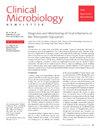触及表面:抗真菌皮肤真菌的兴起
Q3 Medicine
引用次数: 0
摘要
皮肤癣(也称为癣或足癣感染)是一种常见的皮肤、头发或指甲的传染性浅表感染,由皮肤癣菌霉菌引起。从历史上看,临床医生认为皮肤癣是一种轻微的,易于治疗的疾病;然而,在过去的十年中,由于皮肤真菌菌株的出现导致越来越严重和难以治疗的感染,皮肤真菌的流行病学发生了巨大的变化。我们回顾了最近出现的三种引起公共卫生关注的皮肤真菌:在南亚经常引起特比萘芬耐药和难以治疗的癣的毛癣菌,六大洲也有病例报告;在法国和美国,与口腔和肛门生殖器癣感染有关的毛癣菌基因型VII (TMVII),特别是在男男性行为者中;耐特比萘芬的红毛癣菌(Trichophyton rubrum),被认为是难以治疗的癣感染的原因,尽管数据有限。我们讨论了鉴定这些病原体的实际考虑,这些病原体依赖于DNA测序或MALDI-ToF,而不是形态学特征。此外,我们强调抗真菌药敏试验和实际实验室考虑的重要性。最后,我们强调增加对疑似皮肤真菌感染的诊断检测的重要性,以及开发快速、准确和负担得起的皮肤真菌检测方法,以帮助提高诊断准确性和明智地使用抗真菌药物。总的来说,严重和抗真菌耐药的皮肤真菌感染的出现引起了全球公共卫生关注。临床微生物学家可以通过熟悉识别新出现的皮肤真菌种类的技术和进行抗真菌药敏试验来指导患者管理,监测趋势,并为未来的公共卫生干预提供信息,从而在解决这一威胁方面发挥关键作用。本文章由计算机程序翻译,如有差异,请以英文原文为准。
Scratching the surface: The rise of antifungal-resistant dermatophytes
Dermatophytosis (also called ringworm or tinea infection) is a common, contagious superficial infection of the skin, hair, or nails caused by dermatophyte molds. Historically, clinicians have considered dermatophytosis as a mild, easy-to-treat condition; however, the epidemiology of dermatophytosis has changed dramatically in the past decade because of the emergence of dermatophyte strains causing increasingly severe and difficult-to-treat infections. We review three recently emerged dermatophytes of public health concern: Trichophyton indotineae, which is causing outbreaks of frequently terbinafine-resistant and difficult-to-treat tinea in South Asia, with cases also reported across six continents; Trichophyton mentagrophytes genotype VII (TMVII), associated with oral and anogenital tinea infections particularly among men who have sex with men in France and the United States; and terbinafine-resistant Trichophyton rubrum, noted as a cause of difficult-to-treat tinea infections, although data are limited. We discuss practical considerations for identifying these pathogens, which relies on DNA sequencing or MALDI-ToF rather than on morphological characteristics. Additionally, we highlight the importance of antifungal susceptibility testing and practical laboratory considerations. Finally, we emphasize the importance of increased adoption of diagnostic testing for suspected dermatophyte infections, as well as the development of rapid, accurate, and affordable dermatophyte testing methods to help improve diagnostic accuracy and judicious antifungal use. Overall, the emergence of severe and antifungal-resistant dermatophyte infections poses a global public health concern. Clinical microbiologists can play a crucial role in addressing this threat by familiarizing themselves with techniques for identifying emerging dermatophyte species and performing antifungal susceptibility testing to guide patient management, monitor trends, and inform future public health interventions.
求助全文
通过发布文献求助,成功后即可免费获取论文全文。
去求助
来源期刊

Clinical Microbiology Newsletter
Medicine-Infectious Diseases
CiteScore
2.20
自引率
0.00%
发文量
35
审稿时长
53 days
期刊介绍:
Highly respected for its ability to keep pace with advances in this fast moving field, Clinical Microbiology Newsletter has quickly become a “benchmark” for anyone in the lab. Twice a month the newsletter reports on changes that affect your work, ranging from articles on new diagnostic techniques, to surveys of how readers handle blood cultures, to editorials questioning common procedures and suggesting new ones.
 求助内容:
求助内容: 应助结果提醒方式:
应助结果提醒方式:


